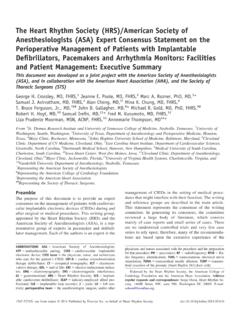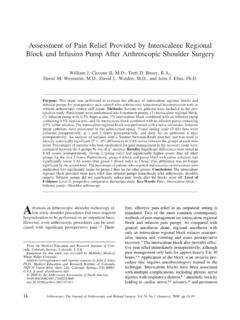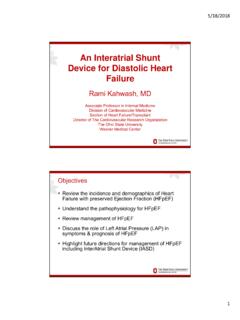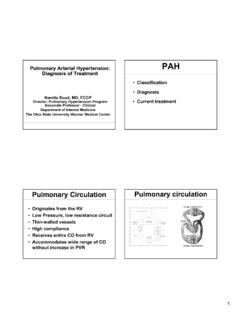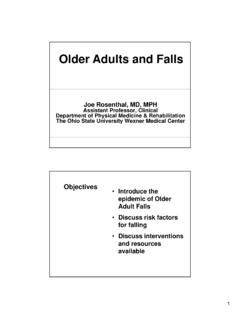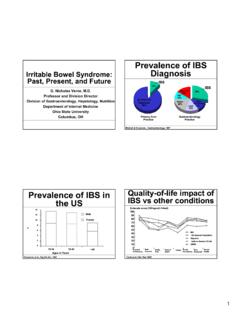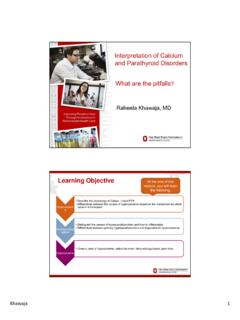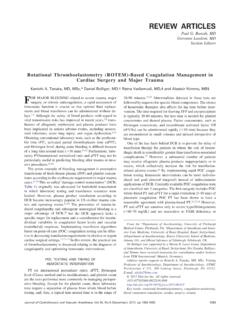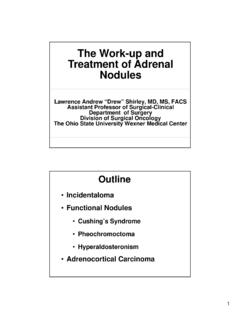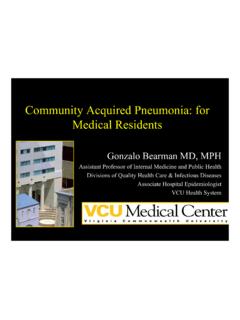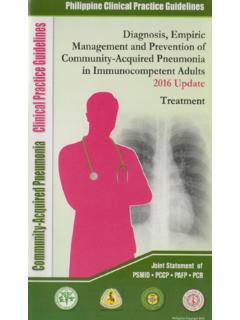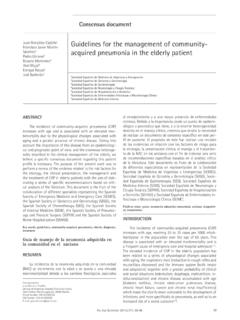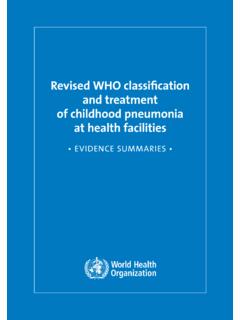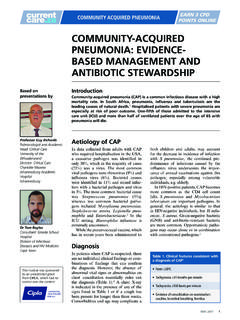Transcription of Community Acquired Pneumonia Final - Handout.ppt
1 1 management of Community - Acquired Pneumonia (CAP): Let s Revisit the Guidelines management of Community - Acquired Pneumonia (CAP): Let s Revisit the Guidelines Let s Revisit the GuidelinesLet s Revisit the GuidelinesJose A. Bazan,DOAssistant Professor of Clinical Internal MedicineDivision of Infectious DiseasesDepartment of Internal MedicineThe Ohio State University Medical CenterObjectivesObjectives Formulate a comprehensive management plan that begins with site-of-care decision, itif thtti lirecognition of the most common etiologic agents of CAP, identification of epidemiologic risk factors for specific pathogens, and a targeted diagnostic work-up. Recognize the recommended empiric and pathogen-directed antimicrobial regimens, optimal timing for transitioning from to , optimal duration of therapy, and preventive measures. 2 BackgroundBackground ~900,000 episodes of CAP/year in adults 65 years in the Significant cause of morbidity and mortality Significant cause of morbidity and mortality.
2 Various studies have demonstrated that guideline-based management of CAP can lead to 30-day mortality, in unnecessary hospital admissions, and length of hospital stay (LOS). Firstjoint IDSA/ATS guidelinesfor First joint IDSA/ATS guidelinesfor management of CAP published in et al. JAMA 2000:283 et al. Acad Emerg Med 1999;6:1243-8 Mandell et al. Clin Infect Dis 2007;44:S27-72 Jackson et al. Clin Infect Dis 2004;39:1642-50 Feikin et al. Am J Public Health 2000;90:222-9 Dean et al. Am J Med 2001;110:451-7 Capelastegui et al. Clin Infect Dis 2004;39:955-63 Case 1 Case 1 Patient X is a 68 y/o caucasian male with underlying insulin controlled DM and HTN. Presents with 3-day history of fevers, productive cough, left-sided pleuritic chest pain, generalized fatigue, and decreased oral intake. Admits to a remote 10 pack-year smoking history. Recently attended a 7-day business convention at a hotel in Philadelphia.
3 Denies recent sick 1 1 VS: Tmax103oF, P112, R22, BP117/68, SPO2 93% RA Gen: A / O x 3, Mildly tachypneic, but able to ,yyp,speak full sentences. HEENT: AT/NC, PEERLA, EOMI, Dry oral mucosa, No pharyngeal erythema or tonsillarexudates. Heart: Regular and Tachycardic. No M/G/Rgy Lungs: Left basilar inspiratory crackles Abdomen: Soft, NT, ND, and normoactive BS Skin: No rashes Extremities: No pitting edemaCase 1 1 WBC 18,000/ L BUN 34mg/dL Cr Glucose = 278mg/dL Nml LFT s4 Outpatient vs. Inpatient management : Severity of Illness Score; CURB-65 Outpatient vs. Inpatient management : Severity of Illness Score; CURB-65 CRB-65 Simplified version to use in et al. Thorax 2003;58:377-82 Capelastegui et al. Eur Respir J 2006;27:151-7 vs. Inpatient management : Severity of Illness Score; Pneumonia Severity Index (PSI)Outpatient vs. Inpatient management : Severity of Illness Score; Pneumonia Severity Index (PSI)Fine et al.
4 N Engl J Med 1997;336:243-50 et al. N Engl J Med 1997;336:243-50 ICU AdmissionDirect ICU Admission 1 Major Criteria OR 3 Minor CriteriaMandell et al. Clin Infect Dis 2007;44:S27-726 Outpatient vs. Inpatient management : Severity of Illness ScoreOutpatient vs. Inpatient management : Severity of Illness Score CURB-65 and/or PSI criteria MUST ALWAYS bltdithALWAYSbe supplemented with physician judgment, especially with outpatient management decisions. Based on CURB-65 score and physician judgment, Patient X was admitted to the hospital for inpatient et al. Clin Infect Dis 2007;44:S27-72 Diagnostic WorkupDiagnostic Workup Identifying a specific pathogen Pros Change in the antibiotic(s) prescribed Unusual pathogens or those that have public health implications (i e TB SARS health implications ( TB, SARS, Legionnaire s disease, etc.) Risk of clinical failure and mortality associated with using wrong or in-effective antibiotic.)
5 Cost, drug adverse effects, and microbial resistance pressure associated with antibioticresistance pressure associated with antibiotic de-escalation. Periodic surveillance of antibiotic resistance profiles for common etiologies of et al. Chest 1999;115 et al. Arch Intern Med 2004;164:502-8 Arancibia et al. Am J Respir Crit Care Med 2000;162:154-60 Mandell et al. Clin Infect Dis 2007;44:S27-727 Diagnostic WorkupDiagnostic Workup Identifying a specific pathogen Cons No difference in clinical failure (p = ), LOS (p),(p = ), or mortality (p = ) between pathogen-directed therapy and empiric therapy groups. Pathogen-directed therapy was associated with improved mortality in ICU patients only (0 02)(p = ). Cost ($$$$$) poor quality samples and overall low-yield of positive cultures in certain patients with CAP. Van der Eerden et al. Thorax 2005;60:672-8 Mandell et al. Clin Infect Dis 2007;44:S27-72 Diagnostic WorkupDiagnostic Workup Sputum for Gram Stain and Culture Perform on good-quality specimens only and before antibiotics are given if i May suggest that broader coverage is needed until cultures finalized ( GPC s in clusters or GNR s).
6 Highly predictive of and can validate f/u sputum culture results ~40% of patients are unable to produce sputum sample at ltil Meta-analysis demonstrated a relatively low-yield of sputum gram stain (presence of predominant morphotype).Mandell et al. Clin Infect Dis 2007;44:S27-72 Gleckman et al. J Clin Microbiol 1988;26:846-9 Van der Eerden et al. Thorax 2005;60:672-8 Reed et al. West J Med 1996;165:197-204 Garcia-Vazquez et al. Arch Intern Med 2004;164 WorkupDiagnostic Workup Blood Cultures Also relatively low yield of positive results (~5 14%)Most common isolated pathogen isS Most common isolated pathogen is S. pneumoniae. No data showing improvement in outcomes or antibiotic selection. LOS associated and use of vancomycin with false-positive results ( coagulase-negative Sth l)Staphylococcus). Optional for those treated as outpatients Should be performed selectively in hospitalized et al.
7 Am J Respir Crit Care Med 2004;169:342-7 Houck et al. Arch Intern Med 2004;164:637-44 Mandell et al. Clin Infect Dis 2007;44:S27-72 Campbell et al. Chest 2003;123:1142 Waterer et al. Respir Med 2001;95:78-82Yu et al. Clin Infect Dis 2003;37:230-7 Diagnostic WorkupDiagnostic Workup Blood Cultures Indications to obtain blood cultures: Severe CAP (S. aureus, P. aeruginosa, etc.) Asplenia(congenital or Acquired ) p(gq ) Complement deficiencies Chronic liver disease Leukopenia on presentation (< 4,000 cells/mm3) Thoracentesis Pleural fluid >5 cm (upright CXR).Mt dflidflilt( bi Must send fluid for analysis + cultures (aerobic and anaerobic). Yield of cultures are low, but findings can influence choice of antibiotics, need for further drainage / decortication, and duration of antibiotic therapy. Metersky et al. Am J Respir Crit Care Med 2004;169:342-7 Metersky et al. Chest 2003;124:1129-32 Mandell et al.)
8 Clin Infect Dis 2007;44:S27-729 Diagnostic WorkupDiagnostic Workup Non-bronchoscopic Bronchoalveolar Lavage (BAL) High % of positive results when performed in (~87%), even after antibiotic therapy, but not (%),py,shown to be superior to tracheal aspirates. Bronchoscopic BAL, Protected Specimen Brush (PSB), or Transthoracic Lung Aspiration. No prospective data evaluating their performance in the initial management of CAP Should consider for immunocompromised patientsor those that have failed standard CAP therapy. Van der Eerden et al. Eur J Clin Microbiol Infect Dis 2005;24:241-9 Mandell et al. Clin Infect Dis 2007;44:S27-72 Rodriguez et al. Ann Emerg Med 2001;38:357-63 Jimenez et al. Chest 1993;103:1023-7 Arancibia et al. Am J Respir Crit Care Med 2000;162:154-60 Diagnostic WorkupDiagnostic Workup S. pneumoniaeUrinary Antigen Rapid (~15 minutes) Sensitivity 50 80% & Specificity > 90% Useful when cultures are not available or able tb bti dhtibiti h bto be obtained or when antibiotics have been given.
9 Cost ($$$$) ~$30 / sample False positive results Children colonized with S. pneumoniae and/or episode of CAP within that last 3 months. Legionella pneumophila Urinary AntigenS1l(8095%f CAP d/tL Serogroup 1only (~80 95% of CAP d/t L. pneumophila) Sensitivity 70 90% & Specificity 99%. Remains positive for weeksMurdoch et al. Clin Infect Dis 2003;37:153-4 Helbig et al. J Med Microbiol 2001;50:509-16 Murdoch DR. Clin Infect Dis 2003;36:64-9 Mandell et al. Clin Infect Dis 2007;44:S27-72 Dominguez et al. Chest 2001;119:243-9 Gutierrez et al. Clin Infect Dis 2003;36:286-92 Murdoch et al. J Clin Microbiol 2001;39:3495-8 Navarro et al. J Clin Microbiol 2004;42:4853-510 Diagnostic WorkupDiagnostic Workup Influenza A/B Rapid Enzyme Immunoassay (EIA) Point-of-care test (~30 minutes) w/ sensitivity 50 70% & specificity ~100% Allows for early initiation of antiviral therapy and implementation of droplet isolation precautionsimplementation of droplet isolation precautions.)
10 Cost (~$30) and sensitivity (high rate of false-negative results) are a disadvantage. Direct Fluorescent Antibody (DFA) Tests Results within ~2 hours Influenza sensitivity compared to EIA (85 95%) and same specificity (100%) Can also detect95%) and same specificity (100%). Can also detect influenza subtypes ( Influenza A 2009 H1N1). RSV Not useful d/t poor sensitivity in adults (20 30%). Charn et al. J Clin Microbiol 2002;40:1675-80 Casiano-Colon et al. J Clin Virol 2003;28:169-74 Mandell et al. Clin Infect Dis 2007;44:S27-72 Kaiser et al. J Clin Virol 1999;14:191-7 Bellei et al. J Virol Methods 2003;109:85-8 Landry et al. J Clin Virol 2004;31:113-5 Shetty et al. Pediatr Infect Dis J 2003;22:789-94 Diagnostic WorkupDiagnostic Workup Acute and Convalescent Phase Serologies Used to diagnose atypical pathogens (Chlamydia pneumoniae, Mycoplasma pneumoniae, and other Legionella spp.)Single acutephase testing isnot reliable Single acute-phase testing is not reliable For the most part, these are impractical Polymerase Chain Reaction (PCR) Respiratory tract specimens ( sputum, BAL, etc.
